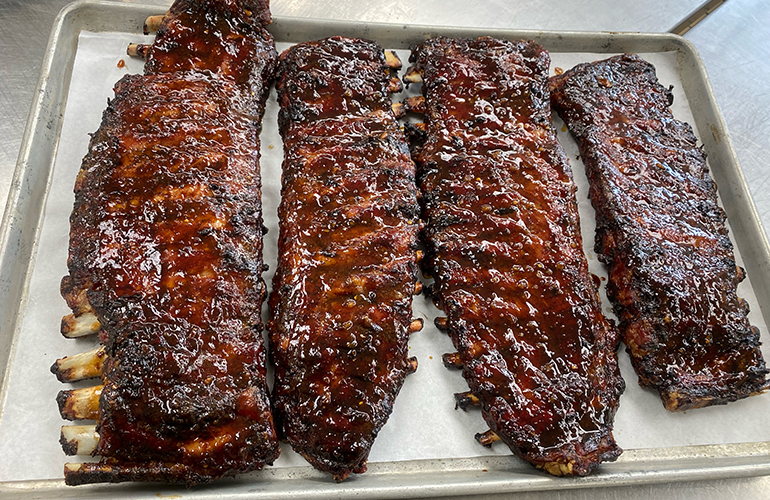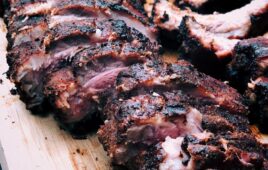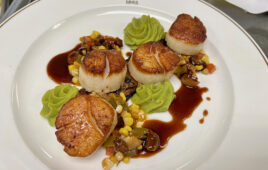
In clubs across the country, chefs-turned-pitmasters are barbecuing all sorts of ingredients—proteins, veggies and even salts—in ways that respect longstanding barbecue traditions but incorporate technology and innovation.
For these chefs, the beauty of barbecue is not only in the eye of the beholder—but also in the chef’s ability to execute.
Where There’s Smoke…
At Oklahoma City Golf & Country Club (Nichols Hills, Okla.), barbecue is beloved, and the club’s program is well-established.

David Ngyuen, Executive Sous Chef, Oklahoma City G&CC
David Nguyen, Executive Sous Chef, is the club’s primary pitmaster.
“I learned how to barbecue on an older double stack that had to be babied,” says Nguyen. “We had to maintain the fire, stoke it, and keep the temperature up.”
Constantly coddling a smoker meant Nguyen and his team had a lot of time to practice different techniques and with different cuts. That practice has since become the underpinning for the club’s program.
“About seven years ago, we upgraded to a new smoker that now does the heavy work,” he says. “We still get to choose the wood we want, but it’s become more ‘set it and forget it.’”
OCG&CC serves barbecue club-wide at least once per week. They prepare everything from brisket and ribs to chicken and specialty cuts.
Most successful is the club’s curbside barbecue program, which runs throughout golf season.
“Our golfers and football fans love brisket, pulled pork and ribs,” says Nguyen.
Every Saturday in season, members can pre-order from the club’s curbside barbecue program. They can pick up their orders between 10 am and 2 pm, and the club does anywhere between $800 and $1,600 in orders each week.
“The preorder step is critical,” says Nguyen. “We make extra just in case, but at least with the preorder, we have some idea of how much to make in advance.”
The weekly base menu includes all the traditional favorites like ribs, pulled pork, potato salad, coleslaw and baked beans. Each week, the club also offers one specialty item like smoked salmon, turkey or sausages.
“Last year, we got creative and did a smoked meatloaf that went over really well,” says Nguyen. “We took a couple of cuts of brisket, shoulder and bacon and ground that down to make a mix with mirepoix, onion, celery, carrots and seasoning. We smoked it the day of service and served it either as a sandwich or by the pound.”
The members loved it.



Typically, OCG&CC does about $6 million in F&B and runs a 42% food cost. Even as the price of ingredients—namely, brisket—continues to rise, demand remains high.
OCG&CC continues to innovate and rely on its smoker for more than just brisket. Nguyen will find ways to incorporate smoked ingredients into most dishes, whether it’s a smoked celery root in a soup or a salt that’s used for finishing.
“We look at smoke as an ingredient all on its own,” says Nguyen.
Stoking the Flame

Jeremy Leinen, Executive Chef, Park Ridge Country Club
Jeremy Leinen, Executive Chef of Park Ridge (Ill.) Country Club, was first exposed to high-end barbecue at The Greenbrier (White Sulphur Springs, W. Va.) during his apprenticeship. While he still considers himself an amateur, he has prepared a fair amount of barbecue over the course of his career. As such, he considers himself a barbecue generalist.
“I was never trained in any specific discipline or regional style, so I don’t follow any hard rules,” he says. “Mostly, I’ve found what I like and what has worked well for me—and I just try to keep it simple.”
“I’ve done whole hogs for smaller events, but it wouldn’t be my first choice to eat or to cook,” he adds. “I’m not big on heavy rubs, either. I would opt to season most meats with salt and black pepper. I’m not a fan of mustard barbecue sauces or the Eastern Carolina vinegar sauces. Even after spending a lot of time in the South, I tend to have a Midwestern palate, and I gravitate toward ribs with sweet and tangy tomato-based sauces.”
At Park Ridge, Leinen (who has been with the club for about eight months) has introduced á la carte barbecue for theme nights.




Jeremy Leinen, Executive Chef of Park Ridge CC, wasn’t trained in any specific barbecue discipline or regional style. But he finds what works, he says—and keeps it simple. At Park Ridge, he introduced á la carte barbecue for theme nights.
“Right before I arrived, the club purchased a new smoker, and it’s impressive,” he says. “It has a five-shelf rotary cabinet, so it offers quite a lot of capacity. We’ve begun by using it for theme nights, but we also plan to put it near the pool on weekends during the upcoming summer. This will not only take the strain off our pool snack bar but will also allow us to offer a better experience for members.”
Leinen says ribs of the St. Louis variety have generally been his strongest barbecue dishes, and he plans to feature them often. They also happen to be his favorite, though he has begun making and serving sausages, too.
“Stick with what you feel best about being able to execute,” he advises. “Championship teams play to their identity.”
It Only Takes a Spark
When Drew Garms came to The Everglades Club (Palm Beach, Fla.) to work under Peter Timmins, CMC, after working at The Greenbrier and Oklahoma City Golf & Country Club, he was tasked with developing a better barbecue program for the club. He requested a smoker but was denied, so he created his own offset smoker using grills and tools from a cold smoker.
“It was a proof of concept,” says Garms—and it worked.
The club and Timmins liked what he was doing and approved the purchase of a smoker. The club’s program grew from there, with brisket and pulled pork served on Saturdays in the men’s locker room, events centered around barbecue as well as theme nights for á la carte.
Garms has a similar barbecue background to Leinen, having worked at The Greenbrier, but says he continues to evolve the program alongside Ethan Hileman, Purchasing Manager, who harnesses technology and innovation to better deliver barbecue to members.
“We’ve come full circle, as our barbecue program is much more technical now,” says Garms, noting that Hileman uses combis for part of the process and prefers to “glue” two deckle cuts together top-to-tail with transglutaminase instead of using the flats for brisket.
“Our brisket is the most succulent,” says Garms. “Plus, our process allows us to remain consistent and flexible in when, what and how we can serve our members.”
Everglades’ secret recipe combines smoking, pasteurizing, bagging and cooling. Hileman remains tight-lipped in regard to the times, temps and details of the process, but he encourages chefs to practice and be creative.
“Take an idea and run with it,” says Hileman. “The technology is there. It’s just a matter of merging technology with tradition.”




